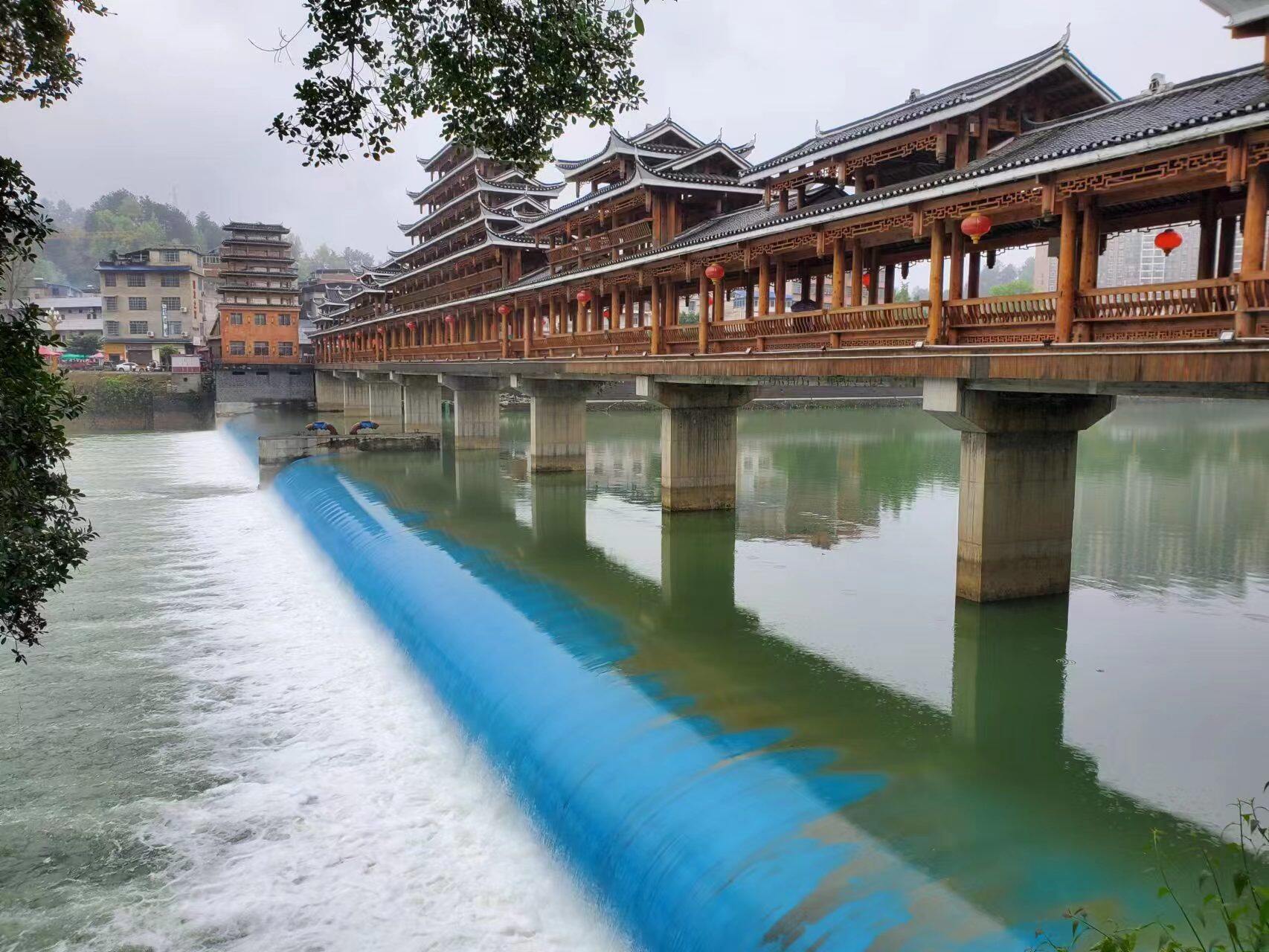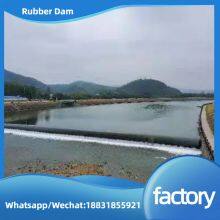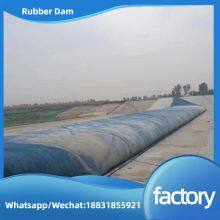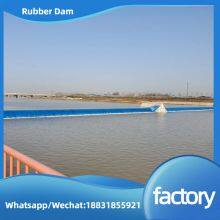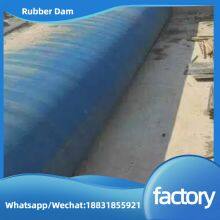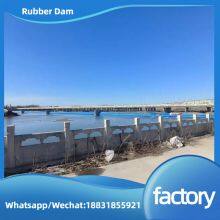Hydropower-Optimized Inflatable Rubber Dam for Mini Hydropower Plants, Flexible Structure & Fast Inflation Function
Inflatable Rubber Dams: How Structure Meets Real-World Needs
Imagine a small river valley: in spring, farmers need water to irrigate wheat; in summer, sudden downpours risk flooding villages; in autumn, local boats need steady water depth to transport crops. For decades, rigid dams struggled to handle these shifting needs—until inflatable rubber dams arrived. Their secret? A design that bends (literally) to match real-world demands. Let’s see how each part of the dam solves specific water challenges.
1. When You Need to "Switch Fast": Flood Control & Dry-Season Storage
The Problem: One structure must act as a water storage tank in dry months and a "disappearing barrier" in floods. Rigid dams can’t lower quickly—by the time you open sluice gates, floods may already hit.
How the Dam’s Design Solves It:
· The rubber dam bag is the star here: made of stretchable, high-strength synthetic rubber (reinforced with polyester), it inflates to 3-5 meters tall in hours to trap water for dry seasons. When rains come, the inflation/drainage system (equipped with fast-release valves) deflates the bag in 10-30 minutes—letting it lie flat on the riverbed, so floodwater rushes through unblocked.
· No need for heavy sluice gates: the dam itself is the adjustable barrier. The concrete foundation keeps the deflated bag from being swept away—its smooth surface lets the bag slide without tearing as it inflates/deflates.
2. When You Need "Precise Height": Agricultural Irrigation
The Problem: Irrigation canals often have uneven slopes—water flows too fast to reach uphill farms, or pools in low spots. Rigid dams fix water levels, leaving some fields dry.
How the Dam’s Design Solves It:
· The inflation system uses a small, adjustable air compressor (or water pump) to tweak the dam bag’s height by centimeters. Raise it 20cm, and water levels in the canal rise just enough to reach uphill wheat fields; lower it 10cm, and you avoid overwatering low-lying crops.
· The anchoring system (anchor bolts + sealing gaskets) ensures no water leaks under the dam. If even a small amount seeped out, it could waste irrigation water—so the gaskets seal the gap between the dam bag and concrete foundation, keeping every drop in the canal.
3. When You Need "Steady Depth": Inland Navigation
The Problem: Small rivers often have shallow spots—boats get stuck, forcing costly dredging. Rigid dams can’t adjust for seasonal sediment buildup; their fixed height may leave channels too shallow after a year of silt.
How the Dam’s Design Solves It:
· The rubber dam bag’s cylindrical shape creates a uniform water "pool" upstream. Unlike rigid dams, which trap sediment at a fixed level, you can inflate the bag 5cm higher each month to compensate for silt buildup—no dredging needed.
· The concrete foundation is built with a slight slope, guiding sediment to the dam’s edges (instead of piling under the bag). This keeps the bag’s base clear, so it always inflates evenly to maintain the right depth for boats.
4. When You Need "Small-Scale Power": Rural Hydropower
The Problem: Remote villages lack access to grids, but small streams don’t have enough water flow for big dams. Rigid micro-dams are too expensive and disrupt local ecosystems.
How the Dam’s Design Solves It:
· The dam bag inflates to create a 1-2 meter "water head" (height difference) in small streams—just enough to spin a micro-turbine. Its lightweight design means you don’t need a massive concrete base (unlike rigid dams), so installation costs are 50-70% lower.
· The anchoring system uses corrosion-resistant bolts (since streams often have mineral-rich water) to keep the dam stable for 15-20 years. Even in freezing winters, the rubber bag’s flexibility prevents cracking—so power generation doesn’t stop in cold months.
5. When You Need "Beauty + Balance": Urban Landscapes & Ecology
The Problem: Cities want artificial lakes for parks, but rigid dams make it hard to adjust water levels—too high, and it floods walkways; too low, and it looks muddy. They also disrupt fish migration.
How the Dam’s Design Solves It:
· The rubber dam bag’s arc shape creates a natural-looking lake edge (no sharp concrete walls). In summer, inflate it to full height for boating; in winter, lower it 1 meter to avoid ice damage—all with a push of a button on the control panel.
· When fish need to move upstream (e.g., spawning season), deflate the bag partially—creating a gentle "ramp" of water that fish can swim over. The foundation’s drainage channels also let small aquatic creatures move between the lake and river, keeping the ecosystem connected.
The Big Takeaway: Flexibility Is the Superpower
Every part of the inflatable rubber dam—from the stretchable bag to the adjustable valves—exists to solve one core problem: water needs change, so the dam should too. It’s not just a structure; it’s a "water tool" that adapts to farms, villages, parks, and rivers—all while being cheaper, easier to install, and gentler on the environment than rigid dams.
A Fresh Perspective on Inflatable Rubber Dams: Structure and Uses
In the field of water conservancy engineering, inflatable rubber dams stand out as a flexible alternative to traditional rigid dams—their light weight, easy installation, and adaptable operation make them a go-to solution for diverse water management needs. To understand how these structures work and where they add value, let’s break down their design logic and practical applications in a more connected way.
How Inflatable Rubber Dams Are Built: A Synergy of Components
Unlike fixed concrete dams, inflatable rubber dams rely on four interrelated components that work together to balance flexibility and stability. At the heart of the structure is the rubber dam bag—the "working body" that holds back water. Made from multi-layered synthetic rubber (such as neoprene or ethylene-propylene-diene monomer rubber) reinforced with polyester or nylon fabric, this bag is engineered to handle two key challenges: resisting the pressure of trapped water and enduring harsh outdoor conditions, from intense UV rays to extreme temperature swings. When inflated, its cylindrical or arc shape forms a reliable barrier; when deflated, it lies flat, letting water flow freely.
To keep this dam bag in place, the anchoring system acts as a secure anchor. Embedded in the riverbed or along the shore, this system uses anchor bolts (fixed in concrete), anchor plates (that clamp the bag’s edges tightly), and sealing gaskets (to prevent leaks at connection points). Without this setup, the dam bag would shift or be swept away by water pressure—turning a functional structure into a liability.
Controlling the dam’s height and operation falls to the inflation and drainage equipment, the "brain" of the system. Depending on the design, this equipment uses either air compressors (for air-inflated dams) or water pumps (for water-inflated ones), paired with control valves and pipelines. When water needs to be stored (e.g., for dry seasons), the compressor or pump fills the dam bag, lifting it to the desired height. When floods hit or water needs to be released, the valves open, deflating the bag quickly to restore full river flow.
Finally, the concrete foundation serves as the "base" that supports everything. Laid along the riverbed, it’s designed to bear the combined weight of the inflated dam bag and the water it holds. Its smooth surface reduces friction as the bag inflates and deflates, preventing wear and tear, while built-in drainage channels stop water from pooling beneath the structure—avoiding long-term damage to the foundation.
Where Inflatable Rubber Dams Shine: Practical Applications
The flexibility of inflatable rubber dams makes them useful across a range of scenarios, each leveraging their ability to adjust water levels on demand.
Managing Water Supply and Flood Risks
One of their most critical roles is balancing water storage and flood control. In river basins prone to droughts and floods, these dams act as "adjustable barriers": during dry months, they’re inflated to trap water, replenishing groundwater and ensuring enough supply for homes, farms, and industries. When heavy rains come, they’re deflated in minutes, opening up the river channel to handle excess water—lowering the risk of flooding without the need for permanent, rigid structures.
Boosting Agricultural Irrigation
In farming regions, inflatable rubber dams are often installed in irrigation canals. By inflating the dam, farmers can raise the canal’s water level, ensuring water reaches even distant or elevated farmland—especially in areas where natural water levels are too low to cover all crops. This not only improves irrigation efficiency but also helps stabilize crop yields, as farmers can control water delivery more precisely.
Enhancing Inland Navigation
For inland waterways (like rivers or canals used for shipping), maintaining a stable water depth is key. Inflatable rubber dams solve this by adjusting water levels to keep channels deep enough for boats and ships. This reduces the need for costly, ongoing dredging projects and makes navigation safer and more reliable—supporting local trade and transportation.
Powering Small-Scale Hydropower
In rural or remote areas, these dams play a role in clean energy production. By inflating the dam to raise the water level of a small river or stream, they create a modest "water head" (the height difference between the water above and below the dam). This head drives small hydropower turbines, generating electricity for communities that may not have access to large power grids—providing a sustainable energy source.
Creating Scenic and Ecological Spaces
Beyond practical uses, inflatable rubber dams contribute to urban and environmental beauty. In cities or scenic areas, they’re used to form artificial lakes, water parks, or wetland habitats. Their adjustable height lets managers control water levels to match seasonal needs (e.g., higher levels for summer recreation, lower levels for winter maintenance), while the stable water environment they create supports aquatic plants and animals—boosting local biodiversity and enhancing the area’s appeal for residents and tourists.

Send Inquiry to This Supplier
You May Also Like
-
Irrigation-Specific Inflatable Rubber Dam for Canal Systems, Durable Surface & Minimal Upkeep Hydraulic StructureUS$ 290 - 300MOQ: 20 Meters
-
Emergency-Ready Inflatable Rubber Dam for Temporary Flood Barriers, Lightweight & Quick Inflation DeploymentUS$ 190 - 300MOQ: 20 Meters
-
Environmentally Friendly Urban Water Feature Inflatable Rubber Dam, Flexible Design & UV-Stabilized Performance for Landscape ProjectsUS$ 190 - 300MOQ: 20 Meters
-
Neoprene Inflatable Rubber Dam With Anchoring System for Ecological Protection ApplicationsUS$ 290 - 300MOQ: 20 Meters
-
EPDM Rubber Dam for Small-Scale Hydropower Generation and Water Level RegulationUS$ 290 - 300MOQ: 20 Meters
-
Low-Cost Inflatable Rubber Dam for Dry-Season Water Storage and Irrigation CanalsUS$ 290 - 300MOQ: 20 Meters
-
Inflatable Rubber Dam for Flood Control and Agricultural Irrigation With Fast Inflation SystemUS$ 290 - 300MOQ: 20 Meters
-
Adjustable Height Inflatable Rubber Dam With Lightweight Design and Low MaintenanceUS$ 290 - 300MOQ: 20 Meters
-
Reinforced Polyester Fabric Rubber Dam for Urban Landscape and Artificial Lake ConstructionUS$ 290 - 300MOQ: 20 Meters
-
Economical Inflatable Rubber Dam With Emergency Deflation Valves and Rapid DeploymentUS$ 290 - 300MOQ: 20 Meters


